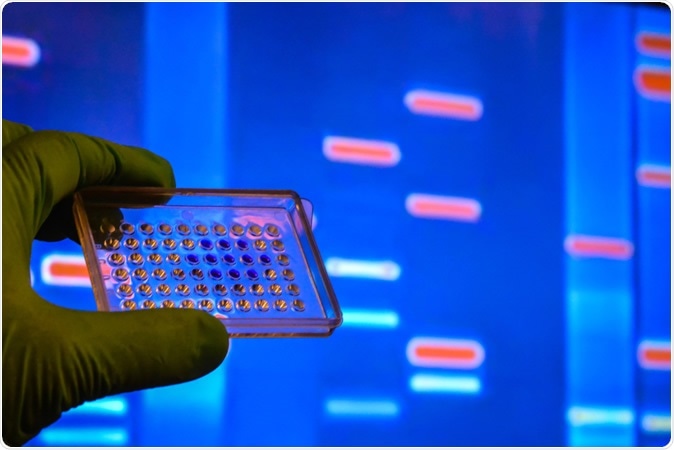
Largest study yet of angiosarcoma reveals new mutations and suggests therapeutic possibilities for some subtypes. Image Credit: Sergei Drozd / Shutterstock
Angiosarcoma is a rare tumor arising within the endothelial cells that line the blood vessels. It can arise in almost any part of the body due to the widespread occurrence of blood vessels. However, the most common sites of this tumor are the skin, breast, liver and spleen.
One of the major difficulties with studying this tumor is its extreme rarity, which means that data is limited. Only about 300 cases arise each year in the US, and patients are scattered. Patients almost invariably succumb to the disease. This makes it difficult to get a sufficient number of cases to analyze so as to discover what drives the disease.
The study was part of the collaborative Angiosarcoma Project. This in turn is a component of the Count Me In movement in which cancer patients with several types of cancer are directly involved in the research, working closely with scientists to help uncover more about this deadly condition. The patients are enrolled in the study online, irrespective of their location. The movement itself took root with the success of the Metastatic Breast Cancer (MBC) Project, which led to a number of discoveries about breast cancer.
The study
In the Angiosarcoma Project, begun in 2017, the patients donate their medical records, blood and other samples of biological tissues, and their experiences and needs, to help move research forward. In addition to the actual cancer-related output, the movement seeks to evaluate the fruitfulness of patient-research partnership when the disease being investigated is rare and research is badly needed for better treatment.
The researchers set up a working group using social media to bring together angiosarcoma patients and their close relatives online. They were then asked for suggestions as to how the project should reach out to other patients. This shaped the eventual form and function of the online portal at ascproject.org, through which any angiosarcoma patient in the US or Canada can enrol for the study. A sizable number, almost 340 patients, actually enrolled in the study within 1.5 years.
The researchers looked at the genomes of almost 50 angiosarcoma specimens, obtained from various patients across the USA and Canada. These genomes were taken from the tumor samples and compared with the inherited DNA taken from the germline cells.
Researcher Corrie Painter, who was herself diagnosed with angiosarcoma back in 2010, says, “When we saw the data for the first time, we were excited to see these discoveries were evident from the genomic data from the very beginning. Working with patients to design and build the project from the start has been a phenomenal experience.”
The findings
There were 30 mutations that were repeated in the samples, depending on the type of tumor. And several, such as PIK3CA, GRIN2A, and NOTCH2, are being reported in angiosarcoma for the first time.
Some of the gene defects suggested a possible role for drugs already being used in other types of cancer. The majority of the PIK3CA mutations were in breast angiosarcomas. These mutations were thought to be activating mutations, that is, they add a function to the gene or enhance an existing function. If so, drugs that inhibit this pathway, such as the already approved P13 inhibitor, can help treat this subgroup of patients who have breast angiosarcomas, with PIK3CA mutations.
Moreover, this family of gene mutations also occurs in breast adenocarcinoma, which is a different type of cancer. This could indicate that an abnormality in the breast cells enhances the chances of tumor development. This line of investigation is due directly to the finding of the mutations in a common gene in two different types of cancer in the same tissue.
Another interesting finding was that the overall mutation frequency was higher in angiosarcomas of the head, neck, face and scalp. These mutations are similar to those caused by ultraviolet radiation and have led to the suggestion that these tumors may have arisen because of solar damage.
Immune checkpoint inhibitors are a type of cancer drug that can be used in tumors with a high mutation burden. The researchers therefore think they should investigate the utility of these medicines in patients with angiosarcomas of the head, neck, face and scalp.
Interestingly, they found that 2 patients with tumors in these areas were put on these medications after conventional chemotherapy failed to control their disease. Both eventually had to stop the treatment because of intolerable adverse effects. However, both are cancer-free today despite not having had any more therapy for their tumors. This certainly is food for thought.
Achievements and future goals
The researchers now need to look for much more solid evidence as to the effectiveness of these drugs but there is more than a glimmer of hope now. Even now, three clinical trials now ongoing have taken in angiosarcoma patients for evaluation of these non-standard treatments, based on unpublished data from this study.
As for the Angiosarcoma Project, enrolment is still on, with 500 patients having enrolled within less than 3 years. Data analysis is still proceeding. The number of patients registered astonishes Painter, who says, “It was an aspirational goal that I honestly didn't know if we would ever reach, let alone achieve in two and a half years.”
Yet, despite the hope offered by these new discoveries, there is also the pain as new and old friends with the disease fall prey to its deadly tentacles over time. Painter pays tribute to these unsung contributors: “The participants in the ASC project have signed up in the hopes that this will help people down the road. We are grateful that in the midst of their own diagnosis, they wanted to do their part to help prevent the suffering of other patients.”
Journal reference:
Painter CA, Jain E, Tomson B, et al. The Angiosarcoma Project: enabling genomic and clinical discoveries in a rare cancer through patient-partnered research. Nature Medicine. DOI: 10.1038/s41591-019-0749-z